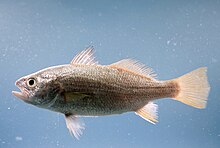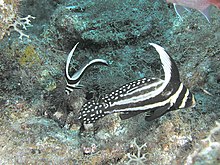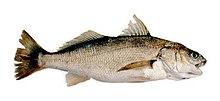Umberfish
| Umberfish | ||||||||||||
|---|---|---|---|---|---|---|---|---|---|---|---|---|

Sea raven ( Sciaena umbra ) |
||||||||||||
| Systematics | ||||||||||||
|
||||||||||||
| Scientific name | ||||||||||||
| Sciaenidae | ||||||||||||
| Cuvier , 1828 | ||||||||||||
The umberfishes (Sciaenidae) family, also known as shadow fish and drummers , consists of 70 genera and 270 species. They were given the name "Drummers" because the males make drum-like sounds during courtship. Umberfish live in the Atlantic , Pacific and Indian Oceans , near the coast, often in the mangrove and in seagrass beds, some in coral reefs , many penetrate into brackish water , around 28 species even only live in fresh water, especially in South America. Umberfish are absent in the central Pacific. Most umberfish live near the surface, very few below 200 m. Almost all of them are important, tasty food fish.
features
Umberfish grow to be nine centimeters to 2.30 meters long. Your body is usually elongated, high back, and slightly flattened on the sides. A characteristic feature is the steep, short first dorsal fin. It is separated from the second by a deep pit, they are seldom completely apart. The first dorsal fin is supported by six to 13 spiny rays, the second by a sting ray and 0 to 35 soft rays. The anal fin usually has one or two soft spines, the second of which can be quite large, and six to 13 soft rays.
The males make their drum sounds by using special muscles to make the swim bladder vibrate. They also stimulate blind bags to emit natural frequencies.
The otoliths , with the help of which the umberfishes hear the species-specific sounds, can be over 30 mm in size, depending on the species and age. Your head channels are usually well developed (often with special pores) - added often come (one to many) mandibular barbels . The scales are medium-sized (two per segment) to very small (5), namely ctenoid scales , but often (smaller) cycloid scales on the head and chest . The snout is rounded, the mouth terminal or below.
The ventral pharyngealia are fused and have squeezing molars. In contrast, the jaw teeth can be weak (vomer and palatine teeth are always missing). The opercular bone is split dorsocaudally; A bone-supported skin flap sits above it. The curved lateral line organ extends to the caudal fin, which is never symmetrically double-lobed, but is often S-shaped at the back. The fish usually swim amiiform , i. H. Propulsion is not generated by the tail, but by the (soft) dorsal fin and the pectoral fins.
Benthic umberfish usually hide during the day and only look for food at night (eyes large, sense of touch important).
Genera and species


- Aplodinotus Rafinesque, 1819
-
Argyrosomus de la Pylaie, 1835
- Argyrosomus amoyensis (Bleeker, 1863)
- Argyrosomus beccus Sasaki, 1994
- Argyrosomus coronus Griffiths & Heemstra, 1995
- Argyrosomus heinii (Steindachner, 1902)
- Argyrosomus hololepidotus (Lacepède, 1801)
- Argyrosomus inodorus Griffiths & Heemstra, 1995
- Argyrosomus japonicus (Temminck & Schlegel, 1843)
- Eagle fish ( Argyrosomus regius ) (Asso, 1801)
- Argyrosomus thorpei Smith, 1977
- Aspericorvina Fowler, 1934
- Atractoscion Gill, 1862
- Atrobucca Chu, Lo & Wu, 1963
- Austronibea Trewavas , 1977
-
Bahaba Herre, 1935
- Bahaba chaptis (Hamilton, 1822)
- Bahaba polykladiskos (Bleeker, 1852)
- Bahaba taipingensis (Herre, 1932)
- Bairdiella Gill, 1861 with seven species
- Boesemania Trewavas, 1977
- Cheilotrema Tschudi, 1846
- Chrysochir Trewavas & Yazdani, 1966
- Cilus Dolphin, 1900
- Collichthys Günther, 1860
- Corvula Jordan & Eigenmann, 1889
- Ctenosciaena Fowler & Bean, 1923
- Cynoscion Gill, 1861 with 24 species
- Daysciaena Talwar, 1970
- Dendrophysa Trewavas, 1964
- Elattarchus Jordan & Evermann, 1896
-
Equetus : Rafinesque, 1815
- Banded knightfish ( Equetus lanceolatus (Linnaeus, 1758))
- Spotted knightfish ( Equetus punctatus (Bloch & Schneider, 1801))
- Genyonemus Gill, 1861
- Isopisthus Gill, 1862
- Johnius Bloch, 1793
- Kathala Mohan, 1969
- Larimichthys Jordan & Starks, 1905
- Larimus Cuvier in Cuvier & Valenciennes, 1830
- Leiostomus Lacepède, 1802
- Lonchurus Bloch, 1793
- Macrodon Schinz, 1822
- Macrospinosa Mohan, 1969
- Megalonibea Chu, Lo & Wu, 1963
- Menticirrhus Gill, 1861
- Micropogonias Bonaparte, 1831
- Miichthys Lin, 1938
- Miracorvina Trewavas, 1962
- Nebris Cuvier in Cuvier & Valenciennes, 1830 with two types
- Nibea Jordan & Thompson, 1911
- Odontoscion Gill, 1862
- Ophioscion Gill, 1863
- Otolithes Oken, 1817
- Otolithoides Fowler, 1933
- Pachypops Gill, 1861
- Pachyurus Agassiz in Spix & Agassiz, 1831
- Panna Mohan, 1969
- Paralonchurus Bocourt, 1869
- Paranebris Chao, Béarez & Robertson, 2001
- Paranibea Trewavas, 1977
- Pareques Gill in Goode, 1876 with about six species
- Pennahia Fowler, 1926
- Pentheroscion Trewavas, 1962
- Petilipinnis Casatti, 2002
- Plagioscion Gill, 1861
- Pogonias Lacepède, 1801
- Protonibea Trewavas, 1971
- Protosciaena Sasaki, 1989
- Pseudolarimichthys Lo et al., 2017
- Pseudotolithus Bleeker, 1863
- Pteroscion Fowler, 1925
- Pterotolithus Fowler, 1933 with two species
- Robaloscion Béarez & Schwarzhans, 2014
- Roncador Jordan & Gilbert, 1880
- Sciaena Linnaeus, 1758 with six species
- Sciaenops Gill, 1863
- Seriphus Ayres, 1860
- Sonorolux Trewavas, 1977
- Stellifer Oken, 1817 with 24 species
- Totoaba Villamar, 1980
- Umbrina Cuvier, 1816 with 17 species
literature
- Joseph S. Nelson : Fishes of the World. John Wiley & Sons, 2006, ISBN 0-471-25031-7
- Kurt Fiedler: Textbook of Special Zoology, Volume II, Part 2: Fish . Gustav Fischer Verlag Jena, 1991, ISBN 3-334-00339-6
- Paolo Parenti: An annotated checklist of fishes of the family Sciaenidae. Journal of Animal Diversity, 2 (1): 1-92. 2020. online
Web links
- Umberfishes on Fishbase.org (English)







